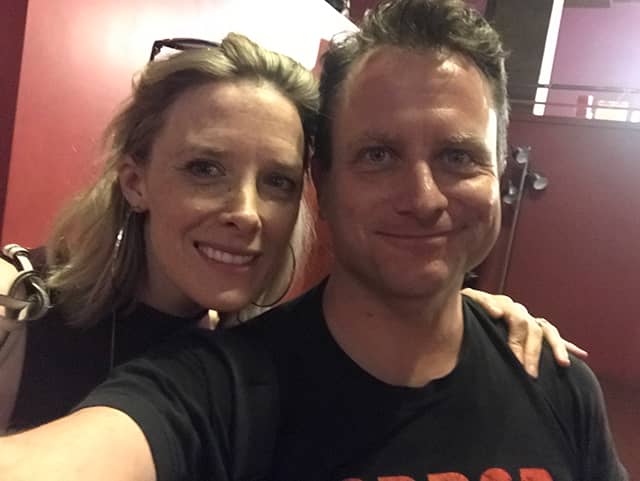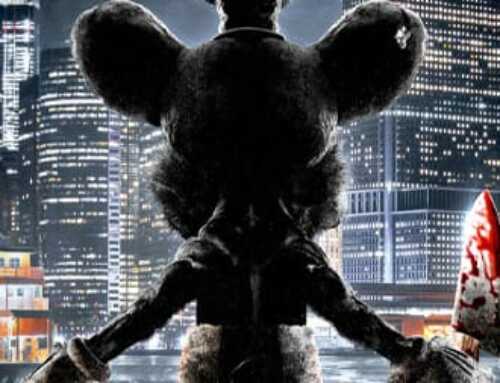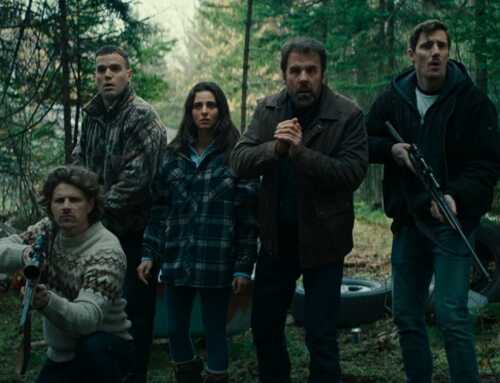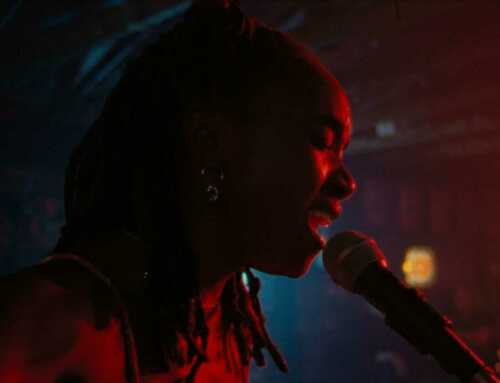We reviewed the fun ghost story, Nails, when it arrived in theaters and VOD earlier this month. Today we share a conversation we had with writer director Dennis Bartok and stars Shauna Macdonald and Richard Foster-King.
It seems that there is far more to making a scary movie than just cooking up a spooky story. There is actually quite a bit of thought, planning, and effort into creating the story and atmosphere needed to truly disturb the audience.
It also helps to hire two very talented actors who are fully committed to telling a story that audiences will connect with. Writer, Director Dennis Bartok is able to breathe new life into conventional tropes pitting Macdonald against a malevolent spirit while being paralyzed and silent in a hospital bed.
Here we explore the story, the process, and how the project came to fruition.
HorrorBuzz: We loved Nails, loved that it was such a great ghost story.
Dennis Bartok: It IS a classic ghost story. When I thought about it during the making of it I conceived it as a horror film but looking at it now with a little distance it DOES have the shape of a classic ghost story. There’s the isolated protagonaist in a very dark place being pursued by an evil spirit.
HB: Yes and there was a mystery. How did this project come about?
DB: My writing partner, Tom Abrams and I saw a news report about a British man who had been paralyzed in a hit and run accident. He had a camera installed in his room because he was afraid one of his nurses was gonna unplug his respirator. Unfortunately it happened.
HB: Intentional?
DB: Accidentally. But it wound up causing irreparable brain damage and the video went viral. That was the kernel for the idea of ‘What if you were trapped inside of your own body and became dependent on technology, a computer to communicate, a voice program to speak, you had a ventilator to breathe, you had to install cameras to be your eyes.’ What if even that at some point gets infiltrated by that evil spirit and the technology turns on you. Then we developed it into the story of Shauna’s character who is an athlete, the mother to a teenage daughter, and she’s the victim of this horrible hit and run accident and she wakes up in this situation then begins seeing an evil spirit and no-one believes her.
HB: (To Shauna) How did you get involved in the project?
Shauna Macdonald: Well it was a straight up offer, which was really nice. I didn’t have to fight to get in the room. Dennis wrote a letter to my agent, we had a Skype call, then after reading it I confirmed that I wanted to be in it. It was that simple.
HB: You had a chance to read the script and…
SM: Oh yes, I am always very choosy, especially with horror. I don’t say yes without, you know. The thing is The Descent was so successful, and in the horror world, especially independent horror films, that they want me to be in their horror film. It’s lovely to be wanted as an actor. I go outside the horror genre and I am battling to get in the room to meet the casting agent. So in the Horror world I have some sort of profile. With that I have a responsibility to be interested in whatever I get involved in, it is challenging. There’s this terrible temptation as an actor to be like, “Oh you want me!” The only control you have as an actor is to say no to jobs.
People ask me, “So why do you keep choosing to do horror films?” and I’m like, “they come to me thank goodness!” It’s really hard to choose a career. It’s really hard as an actor. You are kind of taking what comes until you get to a certain status.
I chose to do Nails because the challenges of Dana (her role) were so extreme. I was telling my husband, “So she can’t speak, and she uses a computer to talk…” Dennis sold it to me in that it was like The Diving Bell and the Butterfly. You are emotionally raw, you have all this going on inside and you can’t move or communicate so well. Usually when I am scared of something I think, ‘Man I can’t do that.’ I could stay in my safe little box as an actor. Or I could just take a big jump into the abyss and see what happens.
HB: That’s where the moments are. The raw moments that you caught on film. (To Dennis) Was Shauna the first choice for the role?
DB: I didn’t write it with anybody in mind and I didn’t write it to shoot in Ireland. That happened to be where the producers were based and where finance came from. The character was actually inspired by a friend of mine, Gretchen, who was a track coach. She was alive at the time when I wrote the script. She had known that I had written the script. I wanted the character to be paralyzed and have so much taken away from her and feel that her marriage is in peril. I tried to think of what she could be that would be the most devastating to her. Coincidentally my wife at the time had known one person that had been killed while out running in the morning and another was killed while biking on Sunset Blvd. It’s actually quite dangerous when you are that healthy and out running in the early morning hours.
HB: Health kills.
DB: (Laughter) That’s true! But as far as the acting goes… With all projects you come up with a listing of actors that you are hoping may say yes. Shauna’s name was actually at the top of my initial list. My now wife had seen it, we are both big fans of Shauna’s work, and my wife said, “You gotta get Shauna.”
I knew that the two things I needed for this film was that I needed to make it scary and I had to find an actor that the audience would connect with and sympathize with, would be complete convincing with her injuries and her slow recovery, and also her emotional inner-life. At times it’s almost a silent movie performance. I can’t think of any other person that could have played that role, and I mean that very seriously. I mean that from the bottom of my heart. I think Shauna gives an amazing performance and she fuels the film in so many ways because she’s in 95% of the movie. She’s in almost every scene. The audience is meant to be with her form the very beginning.
We had Shauna, Richard, Steve Wall, the rest of the cast. I got incredibly lucky. My friend Monty Hellman who directed two lane blacktop said that casting is 95% of directing. I think there is a lot of truth in that. If you select the wright performers then your job is so much easier.
HB: (To Shauna) There was a lot of physicality to your role. It was basically pantomime. You were emoting what was coming out of the computer that spoke for you.
SM: Before we started rolling on the film, I went to record a guide track. We also chose a voice to be the computer as a guide. I think initially the intention was, “we will see what we get, but we will probably redo it.” What we got there was great. I also had a bashed eye, so I couldn’t see out of this eye.
Through the shoot I made a decision to stay in the bed as long as I could throughout the day because if I needed to move out of the bed, I would have to get the prop department to move everything and put it back. When a director yells “Cut” the set suddenly comes alive and everybody rushes in to fix what they saw that wasn’t right.
One day, James Mather, The DP (Director of Photography) saw me like, wincing one day. I was trying to stay in a state, in a level where you are calm but you are ready to act. and I didn’t want to… I love to chat and make friends on a film. On this one I couldn’t do that during the working day. I had to stay at this emotional level. So one day Mather saw me trying to focus and he slipped this noise cancelling headphones on me and I was like “Ahhhhhhh, thank you so much. It was amazing I could just stay in a bubble while everyone did their work.
DB: Yeah, sets are noisy places but I tried to keep the set as quiet as possible because her character is so isolated and alone. We also shot at the Royal City Hospital of Dublin, it’s a semi-derelict hospital in Dublin, kind of in the center of Dublin. We looked at a few different p[laces in the hospital for Dana’s room. over 55% of the movie is in Dana’s room. I wanted as a filmmaker a place where she was swimming in darkness. Where she was in this little pool of light and it was all inky darkness around her. Kurosawa once said that one of the things he did in his films was that he put his characters in spaces that were too big because it made the audience feel a little win edge, unease where they are swimming in a space that was too big. Most hospital rooms are too small. But the big space worked visually and emotionally. It also gave us a lot of room so that we could move the cameras around and create a sense of kinetic motion in scenes when she’s trapped in bed. Like The Diving Bell and the Butterfly or Rear Window, you have a character in one spot, so how do you create tension? You do that by moving the camera in and out, around, using certain beats, noises, banging on walls, creaking doors, footsteps in the hallway that will continue to put the audience on edge.
HB: (To Richard Foster-King) Speaking of inky darkness, how did you get involved in the film?
Richard Foster-King: So I actually auditioned months before for another film. The casting director is based in London and he was working with Dennis on this film in Dublin. I was auditioning for this other role that was a creature role, It was animalistic, very different from Nails. My audition was shared with Dennis for Nails. I think I actually heard about this a month before we actually began shooting. They asked me if I would be interested in doing THIS film and I thought, “Wait a minute, I don’t remember going on for this film.” And so it transpired. Luckily for me they kept me on file after I didn’t book that job. They obviously saw something that they liked.
HB: (To Richard Foster-King) How did you find the character of Nails. He has no dialogue.
RFK: No.
HB: What’s his deal?
SM: Yeah, what’s his problem?
RFK: I think that what was quite attractive for me was that actually we do know how he feels. We know enough about him to be believable. Jumping out of the cupboard to kill Shauna is one thing, but to have a reason why that might have happened… That actually makes it a lot scarier. to humanize him. He’s a ghost of a real person. We know that horrific things happened to him. It’s actually quite sad. I mean for him to be allowed to work in the hospital that he was a patient in is a little troubling.
SM: Yeah. In the movie they say, “Oh giving him a job here seemed like the most natural thing.” and I’m like, “WHAT?!”
RFK: That’s the moment where the audience yells, “NOOO!”
DB: I grew up in a medical family so I can tell you that those things happen. I mean there are only two ways you get out of a hospital. You either get better or you die. My father was a doctor, my mother was a nurse, so I have always found hospitals to be disturbing. That certainly played into the script.
RFK: To me that is a lot scarier. The idea is that you should be safe, but it’s actually what build a lot of the suspense in the film. There are so many curveballs in the beginning. You don’t know if Dana is crazy or not.
HB: But she has just enough lucidity that you believe her. (To Shauna) That’s what makes it work, your assertiveness of you know, listen. “I know what you are thinking”
SM: It’s interesting you say that because watching it I was like, hmmm, maybe I should have played it with a bit more doubt at times. I’m the worst person to watch my own films.
DB: Well the way Tom and I wrote it and the way I envisioned it as a director, was that the audience is in that little pool flight with Dana. We experience the visions of Nails with her, and everyone else is outside. We totally identify with and believe her version of events. Is there a chance that she is nuts? yes. I think that all of the jump scares and the hallucinogenic moments and the sureallness of it, hopefully by the end of the film the audience feels like they are going a little crazy too. You want this sense of “Maybe this all is a hallucination. You could look at Nails as the physical manifestation of everything Dana is afraid of. For me, as a filmmaker, its a supernatural film. But, I hope that for the audience it is a very unsettling experience.
RFK: There’s that extra layer, that family element about losing your family’s trust
HB: The film was a tremendous amount of fun because you rode that balance of, is she or isn’t she crazy. You want to believe her, but she’s also showing signs of insanity.
The film is available now on VOD
| Nails | ||
| RATING: | UR | Nails - Official Movie Trailer (2017) |
| Runtime: | 1hr. 25Mins. | |
| Directed By: | ||
| Written By: | Dennis Bartok, Tom Abrams | |









